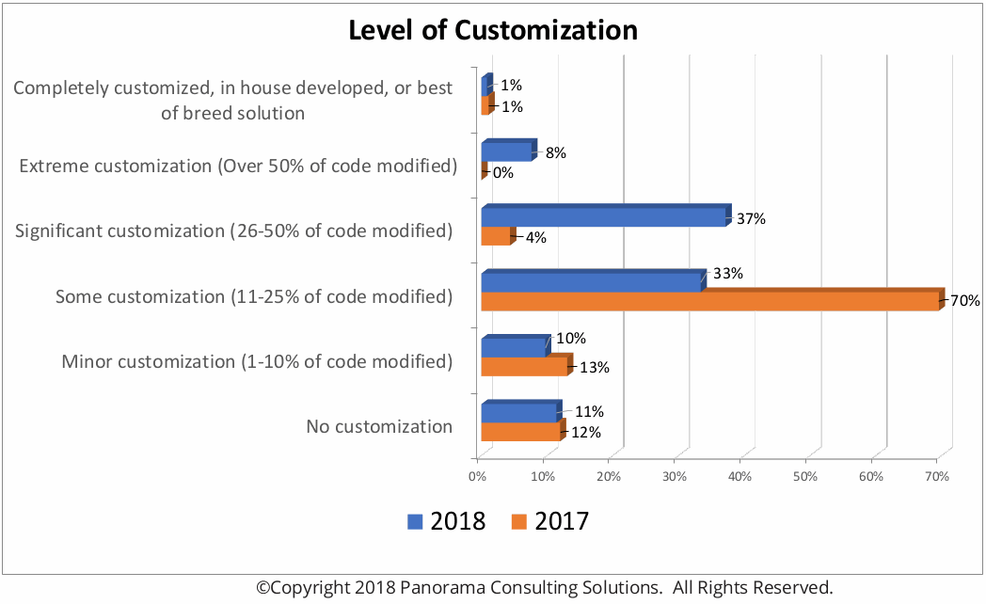Nowadays, most companies are customizing their ERP software. At least 37% of these companies customize between 26% to 50% of their ERP systems.
Advantages and disadvantages of ERP systems are often related to the way you implement the system in your company. That’s closely intertwined with the way you take on ERP customization.
Any ERP disadvantage is firstly always related to the size of the company. If you have more than 20 employees it’s hard to get by without an ERP. Implementing ERP in a scalable approach with a controllable budget, especially focusing on the structural basis of the company, will always be a path to success.
Everything Today is Customized
As we all know, today everything is customized, from our personal social media page to consumer products. It’s a focal feature companies look for when searching for an ERP software to suit them. This is not only to make sure that the system is prepared for their evolution but also due to the era of technologies we live in. In this environment, everything is being updated and innovated and there’s no longer a demand for Closed-Source software.
As mentioned, the market is expanding faster than ever and competition also grows with it. Companies must guarantee their competitive advantage at all costs but off-the-shelf solutions assume you don’t have one. To ensure such an advantage, your ERP can’t be easily copied otherwise anyone could replicate the competitive advantage of your business.
At First, No One Wants to Customize
Most business apps are ready to use but as good as it may sound you might have to add manual procedures around its workflows or change your methods to fit the software. This is where software customization comes in.
Usually customers don’t want any customization initially. They want a system without any changes to the code and no significant adjustment even though configuration and personalizations are always needed.
During the implementation of a new ERP, businesses recognize one or two things that don’t work quite right, prompting them to ask for minor changes to the software. This usually leads to a lot more changes. The 2018 ERP REPORT shows the low number of businesses without customization.
To get a better competitive advantage, ERP software needs to be customized from its key business functions or support capabilities will be added.
Companies that commercialize ERP software aren’t willing to customize it. They don’t want to change the way they do things.
Sometimes, resistance to change results in over-customization of the system. It’s important to consider how the changes align with the business and IT strategies.
Learn How OdooGap Support can Help You
The State of ERP Customization
All organizations go through some kind of customization, usually for these reasons:
- Complexity of processes or transactions
- Supporting competitive advantage
- Size of the organization
Most businesses prefer off-the-shelf ERP, but as the implementation goes by the urge for customizations rises. The 2018 ERP Report shows:
- Only 11% of companies using ERP didn’t have any customization
- 70% had some customization (11 to 25% of code modified)
- 37% had significant customization (26 to 50% of code modified) done

The majority of the participants were large organizations, with 85% representing businesses of $50M worth or more.
Customization varies with company size. Larger companies customize more to keep their competitive advantages. Smaller companies leverage “out of the box” functionalities and best practises.
Does Your Small Business Need Help?
Customization or Configuration?
There’s a difference between software customization and configuration:
- Configuration is the normal setup of the software (fields, workflows, parameters). These changes are part of an installation and don’t need changes to the code. Sometimes, objectives can be met with configuration instead of customization.
- Customization needs changes in the code. It also requires a higher level of technical knowledge. New code is added to the system to allow new functionalities in the ERP. You can ask for new capabilities or removal of features you don’t need.
What do You Need to do to have a Successful Customization?
You need clear business requirements. If they’re not well defined, customization will not help you achieve your goals. Your business requirements will help you choose the right ERP system as well.
A cost-benefit analysis of the customization ensures you’re only changing parts of the ERP that will give you unique competitive advantages. A successful ERP project has your requirements listed according to priority. The project managers look at what can be done within the core functionality of the system and where customization is needed.
Every company is different. Each has its own needs and requirements. No ERP is going to cover all your requirements. So, you need to find the right ERP software that will require minimal customizations.
Have a Odoo or Customization Question?
Advantages and Disadvantages of ERP Customization
Advantages
- Protection of competitive advantages
- Customized to your processes and workflows
- Perfect fit for the company and user
Disadvantages
- Upgrades are more complex, risky and expensive
- Can weaken ERP built-in best practices
- From the main container, you can change the background to highlight features
- Mismatch with business needs
- Helps with changes to business processes
- Quick employee acceptance
- Minimize confusion by removing unwanted features
- Lack of project controls
The Importance of Tech in Business
The Downside of Customization
Some companies have their systems completely customized. Upgrades and maintenance are expensive and very risky. So, they start looking for other software.
Sometimes, customizations don’t work because they’re a symptom of management issues. The custom changes aren’t the problem. The company and its resistance to adopt new business processes and software functionalities are. The business may need to take their investment to organizational management changes.
Most of the time, customized code isn’t supported in system upgrades. During upgrades, it needs to be tested and reviewed.
Open Source ERPs are the Best Solution for Customization
Customizing ERP software isn’t very expensive. If the software is open source, this is especially true. It allows you to keep your processes and remove features you don’t need. Open source software makes the whole process a lot easier.
Odoo is made for customization. With the open code, it’s easy to modify the system without damaging it. Odoo is easily adapted to different industries and business requirements.
An active community of developers is always creating something new. The modules and plug-ins can be added without disturbing the system. There are thousands of modules that you can pick to add to your business. All you need to do is install it.
We are here to help you with your Odoo customization. Take a look at our process.
You will see whether you belong to the customization or no-customization camps. You’ll find where your business fits. It depends on:
- How unique your company is
- Business processes
- How open to change you are
Keep in mind the disadvantages of ERP customisation and find your balance.



